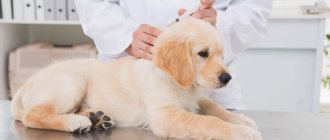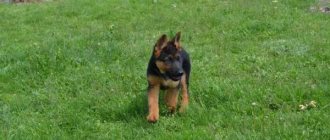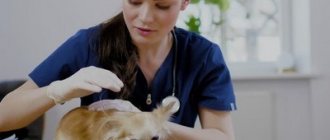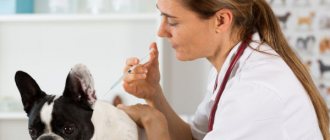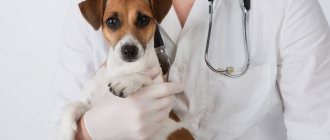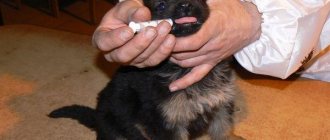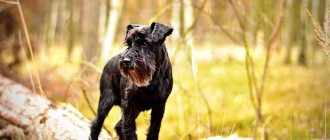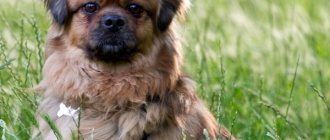Is it necessary to vaccinate a Pekingese dog?
Perceived harm is a key argument of anti-vaxxers. In fact, before introducing a particular drug into veterinary practice, numerous studies were carried out. It happens that a small number of side effects are found during administration. But they can be easily avoided with a thorough preliminary check of the pet’s health.
Examples of healthy, unvaccinated dogs are also often given. But often it's just luck. No one can guarantee that there will be no contact with an animal with rabies or distemper in the future. Even with careful care and maintenance, there is a considerable risk of infectious diseases, which are much more difficult to cure than to prevent.
And finally, the vaccinations received must be noted in the veterinary passport. Animals that have not been vaccinated are not allowed to participate in exhibitions or tourist trips.
Preparing the Pekingese for vaccinations
Main stages of preparation:
- preventive examination by a doctor to detect diseases;
- treatment against parasites. It is necessary to carry out before the first vaccination, then twice a year. Pirantel 1 cubic meter is best suited for these purposes. per kg puppy. The drug is given twice for a more reliable result. The last dose of the drug is a week before the vaccine;
- It is recommended to measure body temperature a couple of days before vaccination. If there is an increase or sudden jumps, it is better to warn the doctor;
- It is necessary to monitor the general condition of the dog. Deterioration in appetite and changes in behavior may indicate the development of the disease. The vaccination will take place without complications if the Pekingese is treated first;
- if the Pekingese has previously been found to be allergic to any medications, you must notify your veterinarian;
- After receiving the first vaccine, the puppy is quarantined for a period of 1 month. At this time, a small dog should not be wet. This means refusing water treatments in any form: do not wash, avoid walking in dew or in the rain.
There are various types of immune preparations for vaccination, but polyvalent vaccinations use in Pekingese . This is what they call vaccinations against several diseases in one bottle. With one injection, the pet receives immunity from two or more infections at once.
What vaccinations does a Pekingese need?
Examples of such vaccines:
- Eurikan – protects vaccinated dogs from rabies, distemper , parainfluenza, leptospirosis, parvovirus enteritis;
- Nobivak – immunizes against plague, adenovirus and parvovirus infections, rabies;
Other vaccines in this series (Vanguard, Hexadog, Duramun and others) are similar in spectrum to those presented. Combinations of infections in such vaccines are selected to prevent the greatest number of diseases.
Vaccination plan
When should you start vaccinations for Pekingese puppies
- The first vaccination should be carried out no later than 2 months . Until the age of 2 months, the puppy has enough immunity; it is protected by mother’s milk.
- revaccination of the puppy - after 2 weeks.
- The second vaccination is recommended at 8 months of age. In this case, the dog's milk teeth must be replaced by permanent ones.
- the third vaccination is carried out a year later.
- the fourth and further – also after 11 months, preventing the complete disappearance of protective antibodies from the pet’s blood.
Timely vaccination of the Pekingese is a manifestation of the owner’s concern for the health of his pet.
Vaccination of Pekingese is practically no different from vaccination of other breeds. However, Pekingese owners should remember that their pets’ bodies can react strongly to foreign substances, even leading to an allergic reaction. But if everything is done correctly, the vaccination will be painless and will protect the puppy’s health for many years.
When and what vaccinations are Pekingese puppies given?
The boy was born on January 5, 2012
INSTRUCTIONS FOR RAISING A PUPPY
——————————————————————————–
Place for a puppy. It is necessary to prepare a place for the puppy (a cat house or a bed with a soft mattress). The place should not be located near a heating radiator or in a draft. Place the bed in a secluded, quiet corner so that it is not in the path, but at the same time the puppy should have a good view of the room from his place.
Toilet. Determine where your puppy will go to the toilet. Train your puppy to go to the toilet on a newspaper. You can use disposable absorbent diapers size 60x90. At first, take the puppy there immediately after sleep, praise him when he does his business in the diaper. Try not to move the diaper too far from where you sleep, or put two in different places. Forgive him for his pranks, he is still small, but at the same time remind him where and what to do. All this will require care, time and patience from you, but in return you will receive long, pleasant communication with a small but such a great friend.
Feeding. A puppy aged from 1.5 to 2 months should be fed 6 times a day, from 2 to 3 months - 5 times, from 3 to 6 months - 4 times a day, after 6 months - 3 times. From 9 months you can switch to 2 feedings a day. Don't overfeed your puppy! Do not suddenly change your feeding diet! At first, the best thing is to feed the puppy the food that he received from the breeder. You need to gradually switch your puppy to other foods. Remember, a puppy has a small stomach, so don’t try to feed it like a Great Dane. Overeating leads to improper metabolism, resulting in imbalance in the body. The puppy should not be given any sweets (pieces of cake, sweets, etc.), pork, lamb, raw liver, smoked sausage, ham and anything else that seems tasty to you. If you want to pamper your puppy, buy special biscuits for dogs, it will be useful for cleaning his teeth and at the same time tasty.
Products for feeding:
Dairy products: Cottage cheese, kefir (milk can weaken), fermented baked milk, cheese.
Egg - it is better to give it boiled, you can make an omelet. No more than once a week.
Meat - beef, both raw and boiled, chicken (boiled only), pork is not allowed in any form. The dog should receive the amount of meat at the rate of 20-25g per 1 kg of weight per day.
Fish – boiled sea fish of low-fat varieties, cleaned of bones.
Cereals – rice, buckwheat
Vegetables – any, raw or boiled (zucchini, carrots, cabbage, etc.)
Add vegetable oil to food every day.
– You can’t give your puppy peas or legumes; spicy, salty, smoked foods. – Never give tubular bird bones or sharp fragments of beef bones. – You can’t feed your dog before an active walk – at least 1.5-2 hours should pass after eating. Approximate puppy diet:
8 hours – porridge with milk (with milk for no more than 3 months) cereals – buckwheat and rice, well boiled. 11 hours – finely chopped meat with grated carrots. 14 hours – vegetables stewed in water, with the addition of finely chopped meat (raw beef, preferably scalded with boiling water) 17 hours – Boiled chicken breast. 20 hours – Cottage cheese 23 hours – The last feeding should always be meat (it is advisable to scald the meat with boiling water)
Grafting Basics
Vaccination is a mandatory procedure that will help preserve the health of your pet. Although she has opponents who argue that after vaccinations the dog may experience side effects.
In fact, before being introduced into veterinary practice, all drugs undergo serious research. Such medications either do not cause negative reactions or are very easy to avoid.
In order for your dog to tolerate vaccination well, it is necessary:
- carry out the procedure only on the recommendations of a veterinarian;
- ensure proper preparation of the animal;
- provide your pet with proper care during the post-vaccination period.
Important! A veterinary passport with marked vaccinations will be required if the owner plans to cross the border with his Pekingese, as well as if the dog will participate in exhibitions.
How to choose a Pekingese puppy?
When choosing a puppy in a nursery, ask to see the parents (at least in photographs and pictures) so that you can understand how he will grow up. Examine the eyes, ears, jaw, fur - there should be no wounds or bald spots anywhere.
The puppy should be active and curious. Also, a dog from a kennel must have a passport and a brand on its stomach.
You should prepare in advance for the arrival of a Pekingese in your home by buying him a house or a bed, a comb (slicker), a nail clipper, shampoos and conditioners for easier combing, and toys.
The collar, food, overalls and carrier are not purchased in advance, as you need to focus on the dog’s data.
The first days should be spent with the puppy , constantly being close to him. His house should be in your bedroom or somewhere near it. The main thing that a Pekingese needs is the care and sensitivity of its owner!
Vaccination schedule
Pekingese are vaccinated according to the following scheme:
- first vaccination - at 2 months;
- revaccination - after 2 weeks;
- second vaccination - at 8 months (mandatory after replacing baby teeth with permanent ones);
- third vaccination - after 1 year;
- the fourth and subsequent vaccinations - annually, 11 months after the previous one.
Important! The above time intervals are approximate and may differ depending on the individual characteristics of the dog, as well as the region of its residence.
It is recommended to vaccinate Pekingese with polyvalent drugs that protect against several diseases at once:
- "Nobivak" - protection against distemper, adenoviruses, rabies and parvoviruses.
- "Eurikan" - protection against distemper, rabies, parainfluenza, parvovirus and leptospirosis.
Vaccination calendar for German Shepherd
It is recommended that German Shepherd puppies receive vaccinations no earlier than the 3rd month of life. Until this time, they receive passive immunity through their mother's milk.
To consolidate the immune response, 3-4 weeks after the first vaccination, a second one is given, called revaccination. In older animals, revaccination is carried out once a year, and in the case of chronic diseases or with weakened immunity, no more than once every 3 years.
IMPORTANT! Early weaning and crowded conditions increase the risk of infection, so the date of first vaccination is shifted to an earlier age.
Vaccination table for German Shepherd puppy by age
The vaccination schedule is individual and may differ for puppies born from the same German Shepherd.
How to prepare a puppy for an injection
In order for your little Pekingese to undergo vaccination with the least risk, you must:
- Take the puppy for a preventive examination, after which the doctor will prescribe an individual vaccination schedule.
- Deworm the baby before the first injection (Pyrantel is most easily tolerated by puppies), and the last stage of taking the anthelmintic should be no later than 7 days before vaccination. In the future, anti-worm medications are given twice a year.
- 2-3 days before vaccination it is necessary to measure body temperature (the norm is 38–39ºС). If there are fluctuations or fever, you need to warn your veterinarian about this.
- It is equally important to monitor the general condition of the puppy. Only healthy dogs can be vaccinated. Therefore, if there are signs of illness, you should also tell your doctor about this.
How to care for Pekingese puppies in the first months of life
When Pekingese are just born, in most cases the mother provides all the care for them. If for some reason the dog does not fully perceive the new position and the maternal instincts are still dormant in it, then it is important to free the puppy from feces and urine on the first day.
This is done by massaging the genital area and anus with a damp cloth or cotton wool soaked in warm water.
You need to drive gently, in a circular motion clockwise and back. But usually this procedure is carried out by the mother, who licks the babies.
Important! Every day it is necessary to change the lining in the basket or other place where the mother and cubs are kept. It is better to put soft diapers there that are easy to wash.
Until the age of 1 month, puppies do not require additional feeding , since the mother feeds them herself. At about two weeks old, Pekingese dogs open their eyes and begin to explore the world. It is important to keep an eye on them so that they do not crawl into an unsafe place.
Pekingese puppies weight
| Birth weight (grams) | 150–170 | 180–200 | 200–250 |
| 1 month | 500–800 | 800–1000 | 1000–1300 |
| 2 months | 800–1000 | 1300–1500 | 1500–2000 |
| 3 months | 1000–1200 | 1500–1700 | 2000–3000 |
| 6 months | 1300–1500 | 1800–2000 | 3000–3300 |
| 8 months | 1500–1700 | 2200–2500 | 3300–3800 |
| 11 months | 1800–2000 | 2500–3000 | 3800–4500 |
| 12 months | 2000–2200 | 3000–3500 | 4500–5000 |
| 18 months | 2200–2500 | 3200–3500 | 5500–6000 |
| small | average | large |
The puppy weight chart is approximate, and to fully understand whether the weight is normal or excessive, consultation with a veterinarian is necessary. Pekingese are divided into three weight categories : up to 2.5 kg, 3.2–3.5 kg and 4–6.5 kg.
It happens that a large dog can develop a dwarf Pekingese. Such babies are in special demand, but they require even more careful care than their larger counterparts.
Puppy care
The main care for Pekingese puppies is to examine the baby's nose, ears, and jaw every day . If an unpleasant odor appears from the ears, it is necessary to wipe the inside of the ear with a cloth soaked in hydrogen peroxide. also important to wipe the crease under the nose of these dogs with a damp cotton swab .
The dog's coat should be carefully combed once every two days to prevent tangles from appearing on the dog. The puppy should be washed or wiped with a damp cotton cloth around the genital area and under the tail. Small puppies are covered with undercoat (baby hair), it is important to remember that you cannot wash growing Pekingese during the shedding period.
In order for
the change of teeth to go smoothly , you need to constantly consult with a veterinarian and buy a special bone that the baby can gnaw on. Nails are trimmed monthly using special scissors - nail clippers.
What to feed a Pekingese puppy in the first months of life?
When the puppies are one month old, you can begin to slowly wean them from their mother , introducing complementary foods into their main diet. Weaning occurs by removing the babies to another bed, which should also be in a fairly warm place where there are no drafts.
Or you can leave the puppies in their basket, but take the mother away for a while.
Options for first feeding for puppies can be the following: baby cottage cheese, milk porridge (ground rolled oats) or meat that is prepared in a special way.
- Baby cottage cheese is diluted with warm milk, but since the puppies do not yet eat on their own, complementary feeding is carried out from a syringe. The main thing is to squeeze out small portions so that the puppy has time to swallow. Or you can let the curd lick off your finger.
- The porridge is prepared simply - crushed rolled oats (1 tablespoon), poured into 150 ml of water, brought to a boil, then turn off the gas and leave the rolled oats for 5 minutes. Cool for 10 minutes, then rub the mixture through a fine sieve in a saucer. Add a drop of honey and a little cream or full-fat milk to the resulting thick composition (jelly). Puppies lick food if they can, and very young children receive it through a syringe.
- meat for Pekingese is beef or veal. A layer is scraped off a piece of frozen meat with a knife, placed on a saucer, and when it is defrosted, this semi-finished product is given to the puppies.
How the dog feels after vaccination
Sometimes a puppy may develop swelling at the puncture site. This is not a deviation from the norm. But if the vaccination site becomes red, swollen, or swelling does not go away after 3 weeks, you should contact your veterinarian.
In addition, within 24 hours after the injection, the Pekingese may have the following reactions:
- body temperature over 39 ºС;
- reluctance to eat;
- diarrhea or vomiting (one-time);
- lethargy, apathetic state.
This is also not unusual. As a rule, the puppy returns to normal the next day. But if your pet’s condition does not improve, you should consult a veterinarian.
Things to remember
Pekingese owners should take into account that this breed is extremely prone to allergies. A negative reaction can even occur to vaccine components. It usually develops within 15 minutes after the injection. Therefore, at this time it is better to stay in the clinic under the supervision of a veterinarian so that he can provide timely help to the puppy if it is needed.
Vaccination is a way to take care of your pet’s health. Any owner will be much calmer if his cheerful and active Pekingese explores the world around him, being protected from viruses and infections.
Raising a Pekingese
Many owners note: Pekingese is a capricious breed of dog , which is inherent in it at the genetic level. But this does not mean that it is impossible to teach a dog basic commands. Pekingese need time with their owner and their attention, so if your puppy is barking too much, you may not be giving him enough time.
The first commands should be learned as soon as the puppy gets to its new home. This way he will receive social adaptation, otherwise, going out for the first time with a curious and brave puppy who does not know the command “Fu!” or “You can’t!” .
You will have to use your hands to remove from your pet’s mouth everything tasty that he smells and gets his teeth into. Repeating commands should be accompanied by constant praise of the pet and the provision of treats prepared with one’s own hands at home.
Advice! Exercise your dog for half an hour a day, every day or every other day. Then in a month the baby will have a clear understanding of commands and a desire to carry them out.
Mastering the tray
Puppies go to the toilet after waking up or after eating. Therefore, the awakened Pekingese is immediately taken to a plastic tray with a grid, on which a disposable diaper is placed. If the puppy went to the toilet there, then continue this every day.
If he makes a puddle on the floor, then blot the newspaper in it and put it in the tray. The puppy will smell the smell and come to the toilet. Not the first time, but after some time the small, clean Pekingese will get used to the litter box.
Adult vaccinated dogs should be allowed to walk outside, as this breed tends to be lazy and play only at the owner's initiative.
Leash and collar training
Accustoming to a collar and leash is the same element of the educational process as teaching basic commands. For a young Pekingese, you need to buy a nylon (silk) or thin leather leash, which you should start putting on him from the age of 2 months for a couple of hours a day.
Under no circumstances should a dog wear this accessory all the time, as the fur may become chafed. You should buy a collar according to the size of the dog so that it does not put pressure and is not too heavy.

